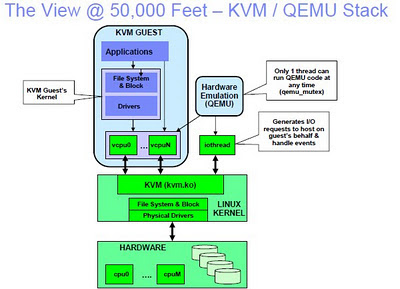Virtualizations: LPARs, LDoms, Xen, KVM, VMWare, and HyperV
IBM LPARs
IBM LPARs is a premium proprietary virtualization technology which sits on top of IBM POWER architecture. It leverages the Virtual I/O Server (VIOS) in order to manage operating system resource requests from other domains.
https://www.ibm.com/developerworks/wikis/display/virtualization/VIO
"This allows a single machine to run multiple operating system (OS) images at the same time but each is isolated from the others. POWER4 based machines started this in 2001 by allowing many Logical Partitions (LPAR) to run on the same machine using but each using different CPUs, different memory sections and different PCI adapter slots. Next came with POWER4, the ability to dynamically change the CPU, memory and PCI adapters slots with the OS running. With the introduction of POWER5 in 2005, further Virtualization items have been added."http://publib.boulder.ibm.com/infocenter/powersys/v3r1m5/index.jsp?topic=/iphb1/iphb1_vios_virtualioserveroverview.htm
"The Virtual I/O Server is software that is located in a logical partition. This software facilitates the sharing of physical I/O resources between client logical partitions within the server. The Virtual I/O Server provides virtual SCSI target, virtual fibre channel, Shared Ethernet Adapter, and PowerVM™ Active Memory Sharing capability to client logical partitions within the system. As a result, client logical partitions can share SCSI devices, fibre channel adapters, Ethernet adapters, and expand the amount of memory available to logical partitions using paging space devices. The Virtual I/O Server software requires that the logical partition be dedicated solely for its use. The Virtual I/O Server is part of the PowerVM Editions hardware feature."

SPARC LDOM's or Oracle VM for SPARC
SPARC LDOM's (or now referred to as Oracle VM for SPARC) is analagous to IBM's LPARs. IBM's VIOS appears to be analagous to Control Domain under. The LDom Control Domain can be subdivided between Control, Service, and I/O Domains - to architect redundancy and additional performance in a SPARC platform. LDom's are a free Solaris SPARC bundled virtualization technology.
http://www.oracle.com/us/technologies/virtualization/oraclevm/oracle-vm-server-for-sparc-068923.html
"Oracle VM Server for SPARC (previously called Sun Logical Domains) provides highly efficient, enterprise-class virtualization capabilities for Oracle's SPARC T-Series servers. Oracle VM Server for SPARC allows you to create up to 128 virtual servers on one system to take advantage of the massive thread scale offered by SPARC T-Series servers and the Oracle Solaris operating system. And all this capability is available at no additional cost."http://en.wikipedia.org/wiki/Logical_Domains
"The Control domain, as its name implies, controls the logical domain environment. It is used to configure machine resources and guest domains... The control domain also normally acts as a service domain. Service domains present virtual services, such as virtual disk drives and network switches, to other domains… Current processors can have two service domains in order to provide resiliency against failures. I/O domain has direct ownership of and direct access to physical I/O devices, such as a network card in a PCI controller… Control and service functions can be combined within domains."There are basic technologies available through LDOM's to developers and architects such as cluster-in-a-box, redundant I/O domains, etc.
http://docs.oracle.com/cd/E19316-01/820-4676/ggtcs/index.html
"In this logical domains (LDoms) guest domain topology, a cluster and every node within that cluster are located on the same Solaris host. Each LDoms guest domain node acts the same as a Solaris host in a cluster. To preclude your having to include a quorum device, this configuration includes three nodes rather than only two."

Xen
There are some similarities to the way these former hypervisors and Xen is architected. Various implementations of Xen exist, such as Citrix Hypervisor, Oracle VM for x86, and OpenSolaris based Xen (now a project under Illumos.) Xen is an open-sourced hypervisor.
http://xen.org/files/Marketing/WhyXen.pdf
"A critical benefit of the Xen Hypervisor is its neutrality to the various operating systems. Due to its independence, Xen is capable of allowing any operating system (Linux, Solaris, BSD, etc) to be the Domain0 thereby ensuring the widest possible use case for customers. For example, many hardware manufacturers leverage NetBSD as their OS of choice for Domain0 and are able to deploy Xen in the manner of their choosing."
"This separation of hypervisor from the Domain0 operating system also ensures that Xen is not burdened with any operating system overhead that is unrelated to processing a series of guests on a given machine. In fact, more are beginning to break up the Domain0 from a single guest into a series of mini-OS guests each with a specific purpose and responsibility which drives better performance and security in a virtualization environment."

KVM
No, this is not a Keyboard switch. Late to the game was a Linux and OpenSolaris based virtualization technology, unfortunately called KVM, for Kernel Virtual Machine. First implemented under Linux.
http://wiki.linuxplumbersconf.org/_media/2010:02-lpc-kvmstoragestackperformance.pdf
Modern OS features such as DTrace and ZFS are now available to KVM after it was quickly ported to OpenSolaris source code base by Joyent for their Open Source SMARTOS cloud operating system and cloud offering
http://www.phoronix.com/scan.php?page=news_item&px=OTc5Ng
"Joyent has announced today they have open-sourced their SmartOS operating system, which is based on Illumos/Solaris. Additionally, this cloud software provider has ported the Linux KVM (Kernel-based Virtual Machine) to this platform.
Being derived from Illumos and in-turn from Solaris, SmartOS does ship with ZFS support, DTrace, and other former Sun Microsystems technologies."

Microsoft HyperV
Some vendors came very late to the hypervisor game. Microsoft HyperV have a similar architecture, available only under Intel & AMD processors, depend on hardware acceleration available under only certain CPU chips from both of those vendors.

VMWare ESXi
VMWare has a great deal of experience in hypervisors, growing out of a software-driven solution, before hardware handlers became popular (and leveraged) in the Intel/AMD world. They provide some of the best backwards-compatibility in the Intel/AMD world.
No comments:
Post a Comment